Table of Content:
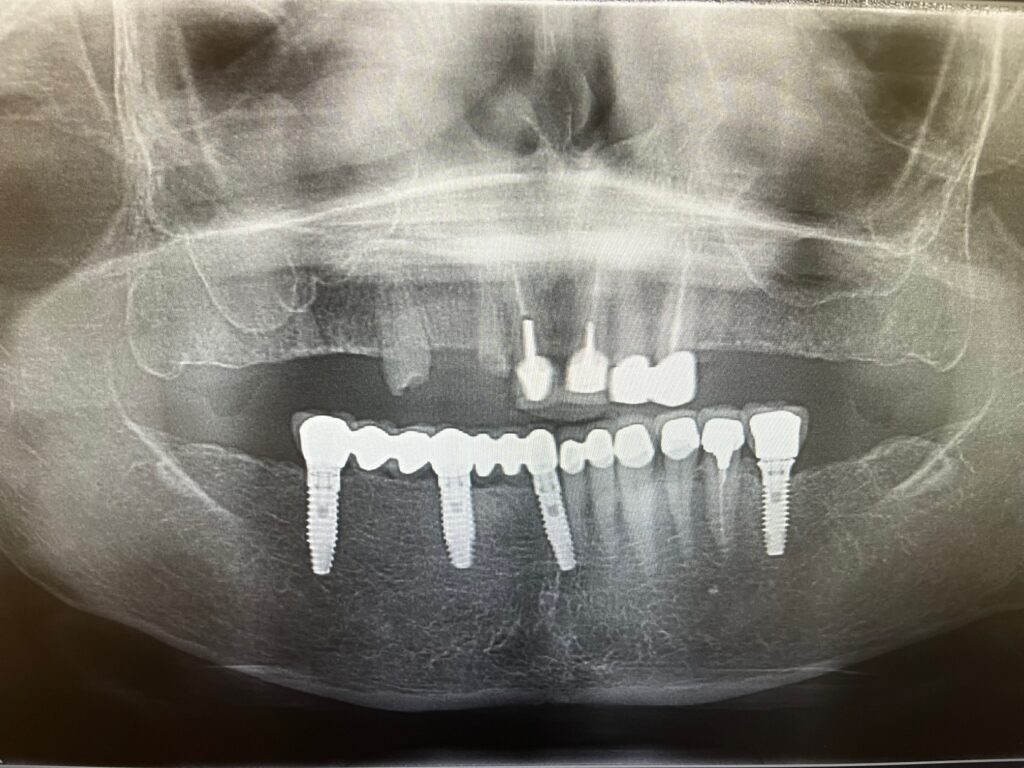
Our patient is a female in her sixties who has lost more than half of her upper teeth. She is down to five front teeth (#7, 8, 9, 10, 11), one of which is unsalvageable (#7), and only one posterior tooth (#5). Here are her chief complaints:
- She is unable to chew due to having almost no back teeth left
- She is depressed about her appearance and avoids smiling and socializing
- She has been unable to use a partial denture
- She continues breaking and losing her upper teeth and is worried that she will lose all of them over the next few years
Luckily, her bottom teeth are in good shape and don't require any work. She has replaced her lower teeth over the years using a combination of crowns and dental implants to maintain a full set of bottom teeth. She has not been as lucky with her top teeth. She tried to wear a partial upper denture but was unable to use it. As a result, she has been walking around with most of her upper teeth missing. She has not been able to smile for ten years due to her misfortune. She presented to our office clinically depressed about her condition. She is looking to replace her upper teeth with a set of permanent teeth using dental implants and wants to explore her options.
The patient wants a fixed solution involving dental implants to fix her upper teeth. There are two ways to fix her mouth with a fixed solution in this scenario:
- Salvage the remaining upper teeth and replace the missing ones with dental implants
- Remove all the upper teeth and replace the entire set of teeth with dental implants
The first option would require implants for the upper right side, extraction and implants for teeth #6 and #7, and implants for the upper left side. This is not a good treatment option for the following reasons:
- The cost of this treatment will be more than the second treatment option
- Placing dental implants in so many specific locations is more complicated than just doing all-on-four implants (all-on-five in this case)
- It would be difficult to match the aesthetics of the old crowns with the new ones.
- The patient will still have five of her original teeth left. If she damages these teeth, she will require more dental implants in the future. The chances of this happening are very high.
Ultimately, the first treatment option makes little sense. The patient is much better off remaining the few teeth and replacing them with dental implants. The patient wisely elected to go for the second treatment option, removing all of her upper teeth and replacing them with dental implants.
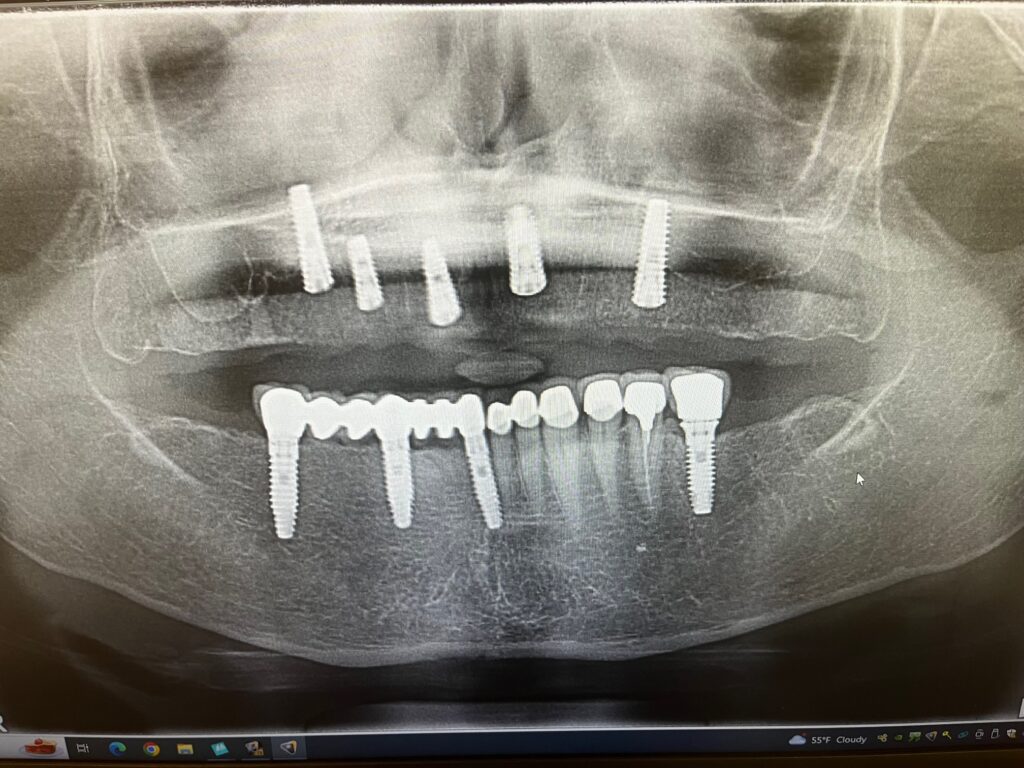
The patient is going with full upper extractions and an all-on-five zirconia bridge. The biggest challenge that our patient faces is a lack of space between the upper and lower jaws. In this case, there was too little space to create a dental prosthesis without risk of fracture. Most patients undergoing implant treatment have too little jawbone for implant placement. This patient had the exact opposite problem where there was actually too much jawbone. Creating a successful prosthesis would be compromised due to a lack of physical space. What is the solution? The patient would have to perform a combination of implant placement AND bone reduction. This allows for the creation of sufficient space to give the patient a bulky set of teeth that resists fracture. Failure to remove this excess jawbone could result in the fracture of the final teeth. We elected to put the patient out, using conscious sedation, during both surgeries.
Tooth removal, bone grafting, implant placement, bone reduction
During a single surgery, we successfully removed the failing teeth and grafted their sites. We also managed to simultaneously place five dental implants inside the upper jaw. Additionally, we removed between 1 to 5 mm of jaw bone in areas with little clearance in order to create room for the final teeth. The patient had to wait 4 months until she was ready for everything to heal.
Second-stage surgery plus corrective bone surgery
During the second surgery, the five implants were exposed. This allows the gum tissue to heal around the implants. Some subtle bone reduction surgery was also performed at this time. The five implants were well-placed and spaced out allowing for a successful restoration.
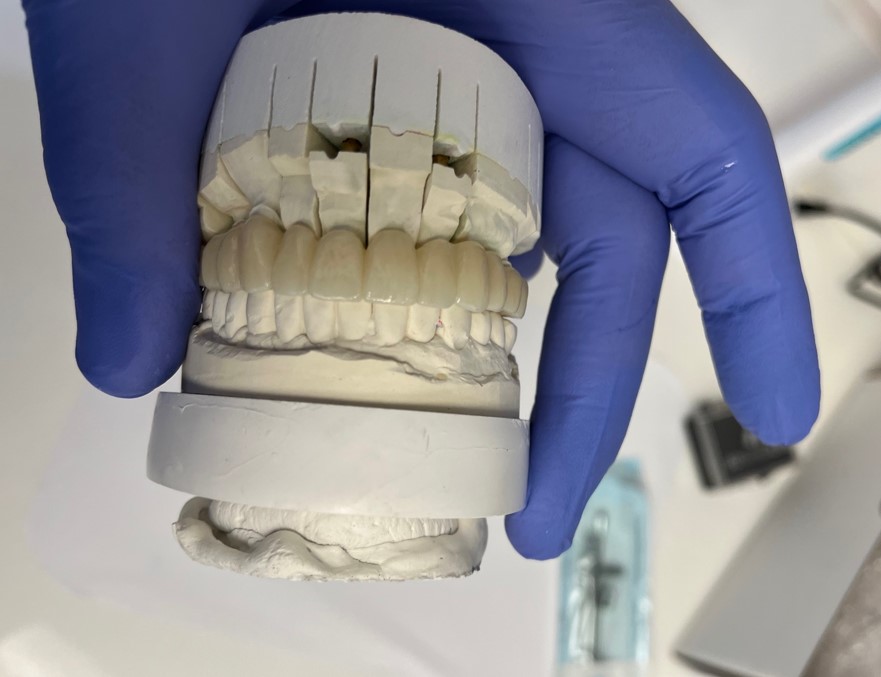
The patient received a 12-unit zirconia bridge that was cemented on top of five dental implants. Adding the 5th implant allowed us to fabricate a cement-retained prosthesis as opposed to a screw-retained one. The benefit in this particular case was that we did not have to incorporate screw access holes on the bridge. Because of the patient's collapsed bite and grinding habit, we wanted to minimize the risk of fracture to the bridge. Fabricating a zirconia bridge without any screw access holes gives us the best chance to accomplish this goal. The prosthesis will be inserted using temporary cement to allow for retrieval in case needed. Here are some of the benefits of going with a zirconia bridge over the porcelain-fused-to-metal alternative:
- Zirconia looks better since it has no need for metals to re-enforce it the same way that porcelain does
- Zirconia is stronger than porcelain and less likely to break
- Zirconia does not strip from the metal substrate the way that porcelain-fused-to-metal bridges sometimes do
Zirconia is heavier than PFM bridges. Adding the fifth implant was beneficial in supporting the added weight of the zirconia brdige.
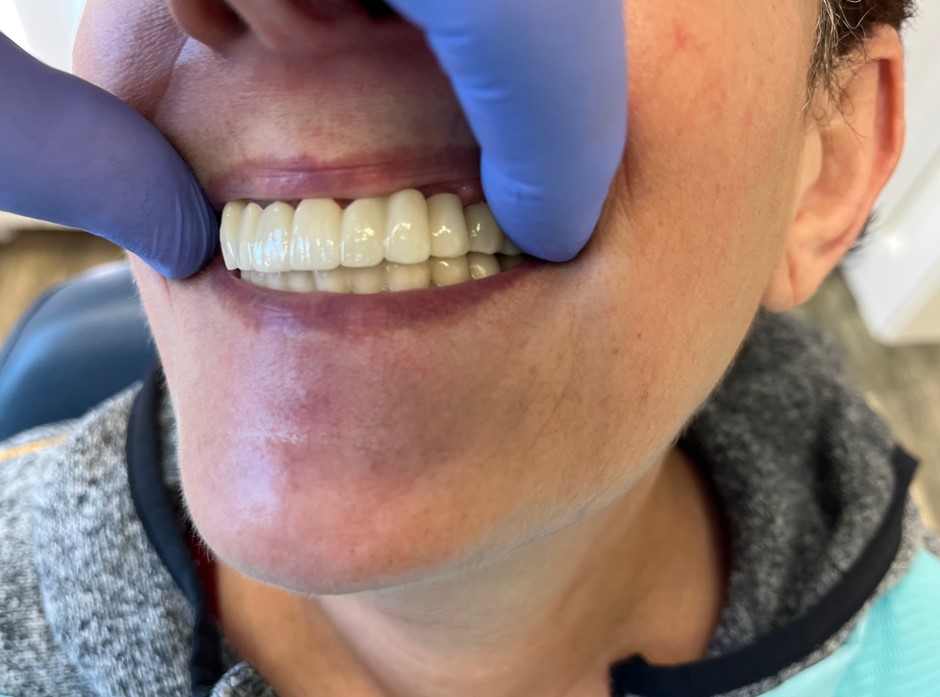
The patient received twelve total upper teeth, 6 anterior and 6 posterior teeth. The twelve teeth are more than enough to provide a perfectly balanced bite. There is no need for any additional teeth as there are no opposing lower teeth for the 2nd molars. Placing additional teeth would only result in cheek-biting and discomfort. It also increases the risk of bridge fracture due to creating unwanted cantilever forces. It is very important to establish an even and calibrated bite relationship. We made sure that all the left and right teeth touch the same during mastication. The patient has to learn to bite her food on both sides of her mouth. This will protect her new bridge and prevent future problems. Also, there was no need to incorporate any pink gum tissue since there was sufficient jawbone in place. Most all-on-four (5 or 6) implant bridges require some pink gum tissue to replace the missing gums. This patient had little missing gum tissue, so the bridge sits flush against the gum tissue. As a result, no pink ceramic was required in this case.
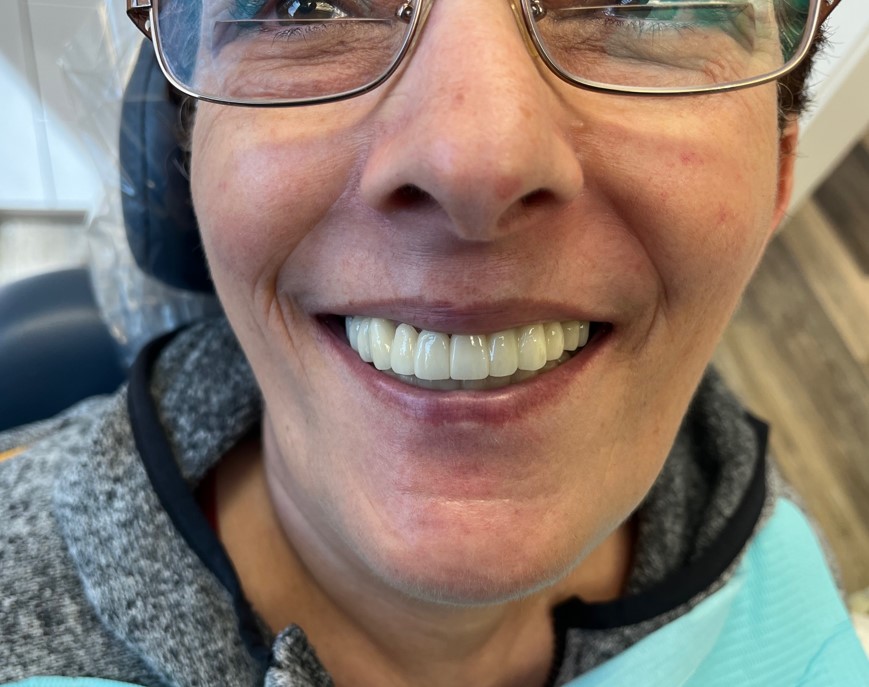
Caring for an implant-supported zirconia bridge is earlier than most think. There are no more teeth left, so you don't have to worry about cavities or infections. Of course, you should continue seeing your dentist for annual cleanings (or whatever they recommend). Consider using a Waterpik for home hygiene. You can brush the prosthesis using a soft toothbrush only. A manual toothbrush is recommended since electric brushes can interfere with the implants or the adhesion of the bridge. You can not floss the prosthesis since the teeth are attached to one another. Overall, there is little maintenance required for a well-fitting all-on-five bridge. You can pretty much chew everything you would chew with natural teeth. This includes pizza, bread, vegetables, and most hard food objects. Avoid chewing on ice, cracking pistachio shells, nail-biting, etc. as these are not okay. Enjoy your new teeth and treat them like you would treat your own teeth.